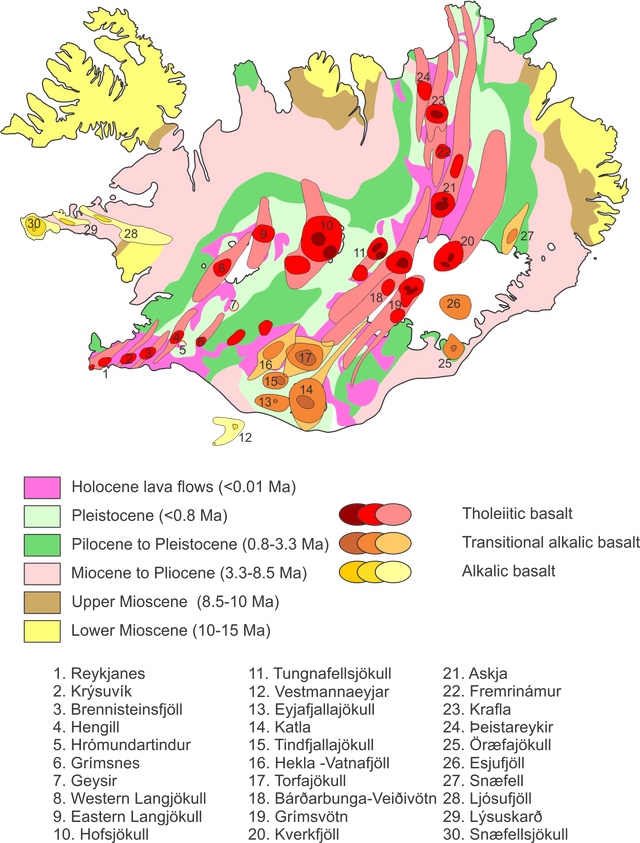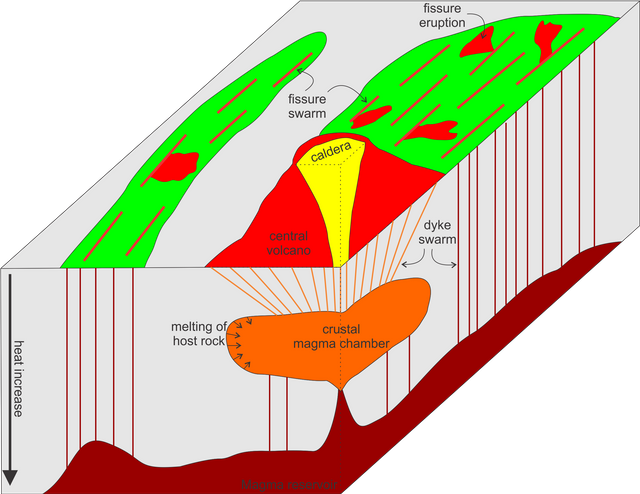Geology of Iceland - Part 5: Magmas and Rocks
Introduction
We have moved closer and closer towards Iceland, starting with the big picture ideas and moving towards the way volcanism occurs. In this post I want to introduce the different magma types, as well as the most basic igneous rock types that are formed on Iceland.
At first I want to look deep into the Earth and explore the different parts of the upper mantle that melt to create the magma that consequently forms the island. Afterwards I want to talk about the different crystallization processes and types of magma transportation that leads to the variety of rock types that can be found on Iceland.
Magma Sources
Looking at a regional scale map of Iceland, we can see that scientists observe three different magma compositions across the island. Along the main rift zone, tholeiitic basalts form the majority of the eruptions. At the exterior of the island, at the Vestmannaeyjar and Snæfellsnes Volcanic Zones, alkali basalts are exposed at the surface. Between the Vestmannaeyjar volcanic zone in southern Iceland and the main rift zone, transitional basalts can be found, that vary in composition from alkali basalt to tholeiitic basalt.

Tectonic map of Iceland with active volcanic systems, divided by magma compositon.
Simplified after Jóhannesson and Sæmundsson (1998). Based on data from The Icelandic Institute of Natural History (license). Basalt compositions taken from Sigmarsson and Steinthorsson (2007). Names of volcanic zones from en.wikipedia.org.
These differences have been the cause of debates for decades and are currently believed to reflect different melting conditions in the underlying mantel. The material that makes up Iceland originates from melting in the upper mantle. Here they originate at temperatures ranging from 700 and 1300 °C. Three distinct mantle components are involved in the formation of Icelandic basalts.
- depleted upper mantle similar to mid ocean ridge basalt (MORB – see part 3)
- upwelling mantle plume material (see part 2)
- recycled oceanic crust scattered throughout the mantle.
The recycled oceanic crust is present in the upper mantle as eclogite or garnet-pyroxenite. These two materials melt at lower temperatures compared to the ambient mantle lherzolite. Melting of these materials could yield alkali basalts, depending on their composition. In the active rift zones, higher temperatures melt not only the recycled oceanic crust, but also the ambient lherzolite. The percentage of lherzolite present in the mantle vastly exceeds the amount of recycled oceanic crust. High percentages of melt therefore lead to a dilution of the alkalic signature. The composition of the resulting basalt will be tholeiitic.
This scenario explains why alkali basalts are only present at the outermost Icelandic volcanoes. The mantle temperature is expected to gradually reduce when you move away from the plume center beneath Vatnajökull and will be the lowest at the periphery of Iceland. In line with this, the transitional compositions observed along the off-rift volcanic zone in South Iceland results from increased input of lherzolite melting that gradually dilutes the alkalic signature.
Other Magma types
Besides the composition of the material that has been molten to form the magma, the physical parameters present during these melting processes influence the composition of a magma. High temperature melts for example are usually mafic in composition, with low silica contents and high magnesium, iron and calcium contents. Low temperature melts on the other hand are usually silica, aluminium, sodium and potassium rich. At temperatures in between, intermediate compositions are formed. Intermediate magmas can also be the product of mixing between mafic and felsic endmembers.
In addition to the already mentioned temperature increase towards the plume center in Iceland, temperature generally increases gradually with depth. The rate of temperature increase per unit of distance is known as the geothermal gradient. Away from any active plate boundary, underneath average crust, this geothermal gradient averages around 25°C/km. This is not the case in Iceland. The active spreading center, in combination with the underlying plume, creates enormous geothermal gradients. Beneath the volcanic zones, geothermal gradients can be as high as 200°C/km. Depending on their distance from the active volcanic zones, the other parts of Iceland have geothermal gradients that vary between 150°C/km and 50°C/km.
As a result of the increasing temperature, deeper-seated magma reservoirs are composed of mafic magma that formed by melting of the upper mantle. Magma from these reservoirs feeds into the fissure swarms in the volcanic zones and is responsible for the majority of basaltic volcanism on the island.
Magma chambers stationed at shallower depths have a more complex magmatic composition. They can contain all three magma types previously described. The shallow magma chambers are fed with basaltic magma from the underlying deeper seated magma chambers. The melting of the surrounding crust produces felsic magmas. These two compositions mix, forming intermediate magmas. The shallow magma chambers are the source for eruptions at the central volcanoes. This explains why the only places on Iceland that intermediate and felsic magmas erupt alongside basaltic magmas are at those volcanoes.
Classification of magma types based on chemical composition. Nomenclature of rocks, environment of solidification and melting temperatures included:

Formation of Igneous rocks
Magma reaches the surface via channels within the volcanic systems. During this process the magma cools, leading to crystallization and the formation of igneous rocks. Magmas are injected into the crust. But not all of it is making it all the way to the top. Some magma gets stuck in the crust. These rocks are labelled as intrusive rocks. The deeper the magma gets stuck, the higher the surrounding temperatures are. If the magma gets trapped in the deeper parts of the crust, where the temperature is still very high, it crystallizes very slowly. Slow crystallization over time forms large crystals, and the rocks are summarized under the term plutonic rocks.
In Iceland we can find these kind of rocks in the root zone of the central volcanoes. They represent the solidified magma chambers that once fed the volcano above it. Depending on the magma composition, these plutons can form gabbros, diorites or granites.
Magma that reaches shallower depths before crystallizing, evolve in a colder environment, leading to faster crystallization rates. They are forming medium to fine-grained hypabyssal rocks.
In Iceland, these rocks occur as sills and dykes and form doelrites, microdiorites, or microgranites, depending on their composition. Sills are emplaced parallel to the layering of the surrounding rocks (usually horizontally), whereas dykes cut through the surrounding layers (usually vertically). Dykes form the channels that transport magma upwards and commonly represent the feeder systems for overlying eruptions.
The magma that makes it all the way to the top pours onto the surface as lava. Here, it cools rapidly, leaving nearly no time for crystallization. They form fine gained rocks that, depending on their initial composition are called basalts, andesites, or rhyolites.
These form the majority of rocks that are exposed on Iceland’s surface.

Sketch of a quarter of a volcanic system in Iceland. An elongated magma chamber is located at the base of the crust. The reservoir feeds fissures that form parallel swarms at the surface. It also feeds a secondary reservoir that underlies a central volcano.
Drawn by the author. Inspired by Gudmundsson et al. (2009) and Thordarson and Höskuldsson (2014).
Other Rock types exposed?
At last I should address the overall distribution of rock types on Iceland. Although I sometimes tend to ignore it, igneous rocks are not the only common rock type. Geology divides rocks into three groups:
- Igneous rocks, which are crystallizing from molten material.
- Sedimentary rocks, which are formed by secondary deposition of material
- Metamorphic rocks, which are formed by re-crystallization of preexisting material due to temperature and pressure changes.
On earth, igneous processes first formed the crust. Around 95 percent of todays crust is represented by igneous rocks and their metamorphic equivalents. Sedimentary rocks are limited to the outermost layer of the crust (upper 2-3 km). They make up around 75% of rocks that are exposed on the surface, given that the external processes (e.g., erosion) that form these rocks, operate here constantly and deposit the rock back on to the surface. The things that go on beneath the surface, where igneous and metamorphic processes dominate are mostly hidden to the observer.
Things are somewhat different in Iceland. Here the percentages are reversed. The majority (80-90%) of the exposed rocks are igneous. Of these igneous rocks, nearly 90% are mafic in composition. The rest are intermediate or felsic. Sedimentary rocks account for 10-20% of Iceland’s stratigraphy. And if you did the math already, you have realized that we’re out of space, which means that metamorphic rocks are not present on the island at all.
A real paradise for volcanologists.
Previous posts
Geology of Iceland - Part 1: Introduction
Geology of Iceland - Part 2: The Iceland hotspot
Geology of Iceland - Part 3: an island being ripping apart
Geology of Iceland - Part 4: Volcanic Systems
References
- Arnórsson, S., Axelsson, G., and Saemundsson, K., 2008: Geothermal system in Iceland, Jökull, 58, 269-302.[link]
- Baldursson, S. and Ingadóttir, Á (2007). Nomination of Surtsey for the UNESCO World Heritage List. Icelandic Institute of Natural History, Reykjavík, 123 pages.[link]
- Best, M. G. (2002). Igneous and Metamorphic Petrology, 2nd Edition. Wiley-Blackwell. [link]
- Markl, G. (2008). Minerale und Gesteine, 2. Auflage. Spektrum Akademischer Verlag. [link]
- Sigmarsson, O and Steinthorsson, S. (2007). Origin of Icelandic basalts: A review of their petrology and geochemistry. Journal of Geodynamics 43, 87-100. [link]
- Thordarson, T. and Höskuldsson, Á. (2014). Classic Geology in Europe 3: Iceland. Second Edition. Dunedin Academic Press Ltd, 256 pp. [link]
- https://en.wikipedia.org/wiki/Geothermal_gradient

I like the first diagram a lot, shows how the island slowly but steadily changed over time. If I am reading it correctly, it shows that the oldest magma is on the edges of the island, which would make sense. Is that correct?
Yes, it is. Because of the structure of the mid ocean ridge, material is slowly pushed outwards, resulting in the observable age progression from the center to the edge of the island.
Perfect place for a volcanologist, as you said. Everything is there to see
Hello @sooflauschig
This article reminds me of the fact that our world and everything therein works on the principle that seeks to achieve equilibrium at all times. When the conditions underneath the ground are not in balance as could be created by geographic and chemical changes taking place there, the imbalance eventually causes fissure and eruption occurs.
Your description of formation of various rock types remind me of my high school Geography. I first heard of magma while taking Geography as a course. My memory is highly refreshed on this now.
Detailed article. Kudos
Regards
@eurogee of @euronation and @steemstem communities
Hi @sooflauschig!
Your post was upvoted by utopian.io in cooperation with steemstem - supporting knowledge, innovation and technological advancement on the Steem Blockchain.
Contribute to Open Source with utopian.io
Learn how to contribute on our website and join the new open source economy.
Want to chat? Join the Utopian Community on Discord https://discord.gg/h52nFrV
You received a 80.0% upvote since you are a member of geopolis and wrote in the category of "geopolis".
To read more about us and what we do, click here.
https://steemit.com/geopolis/@geopolis/geopolis-the-community-for-global-sciences-update-4
Hey mate, awesome post as always! I am not sure if you touched about this yet but one of the Volcanoes in Iceland is the key for the story "Journey to the Centre of the Earth". Snæfellsjökull, I believe... hopefully one part of your Iceland series will touch upon this (even obliquely). Have a great weekend!
I am slowly working my way towards the volcanoes. I think the next post will probably start with the general edifices and then I hope I can go into examples. If that is the case Snæfellsjökull definitely needs it's own mention.